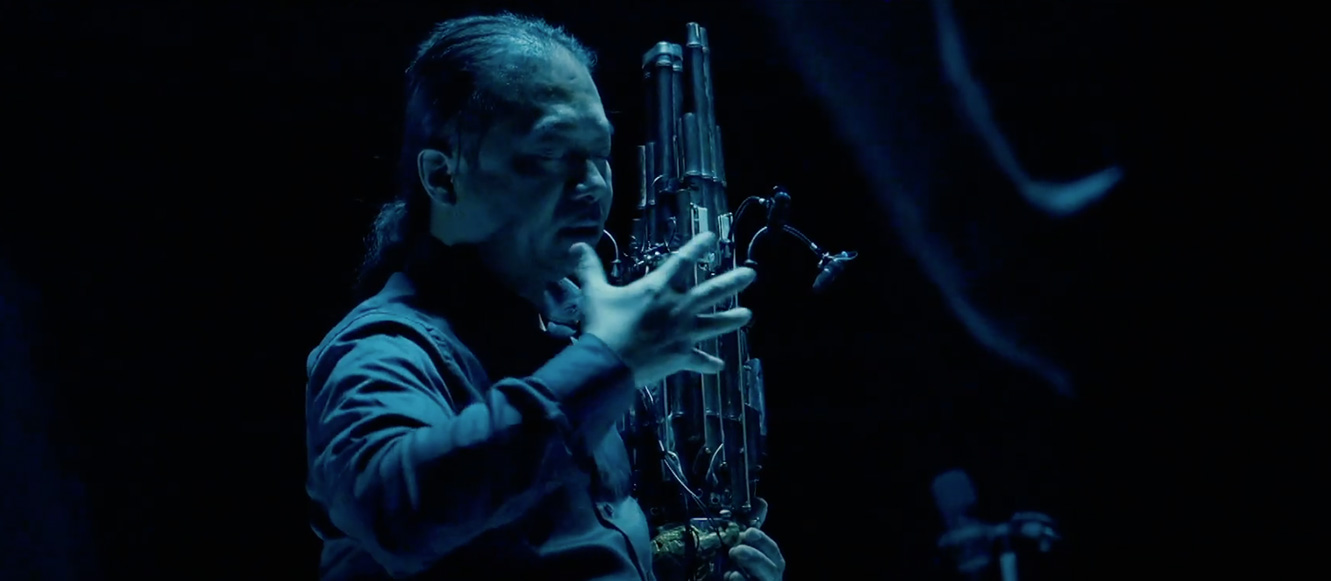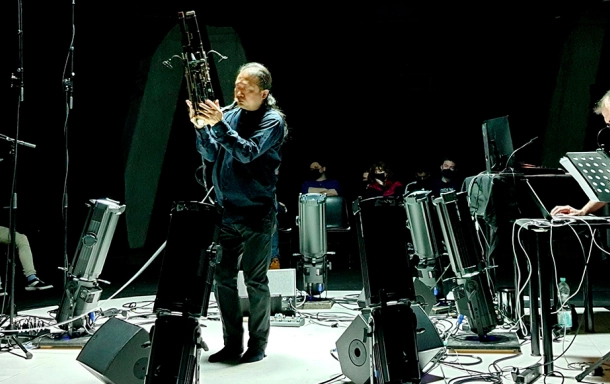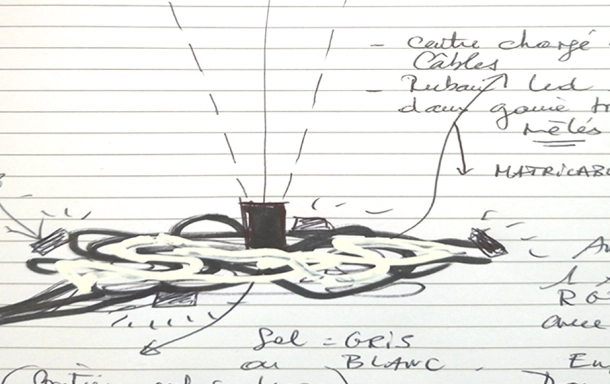Electronic augmentation and listening direction through the renovated 37-pipe model (extension of the traditional mouth organ model) is at the center of this research and creation
Bamboo Forest is the first empirical research project (2021-2024) within the framework of the sheng! mouth organ project (2019-2024) which has been supported by several institutions and brings together six teams of researchers on the themes of history, acoustics, organology, musical analysis on the Chinese millennial instrument - the mouth organ - sheng.
The realization of the research - creation in the first period in May 2021 and January 2022 was accompanied in co-production by the GMEM in the form of a residence at the Module.
This third residency with the support of the GMEM will be an intensive period for the realization of the creation of the American composer Julie Zhu resulting from the commission of Radio France for France Musique, the program Création Mondiale of Anne Montaron.
-
"When two sounds are emitted at the same time, they can produce, under the influence of non-linearities, in addition to their harmonics, at least two other sounds, which are called in English "sumtone " and "differencetone". This is what is called in science intermodulation. For the "sum" sound, the frequencies of the two original sounds are added, while the resulting frequency of the "difference" sound is the difference of the two original frequencies. The musical effect is an expansion of harmony, but beyond that, I am curious about the everyday implications of the "sum" and "difference" sounds in our daily lives.
The sheng, an ancient Chinese instrument, is a free-reed wind instrument with vertical bamboo pipes. One of the specific acoustic characteristics of this instrument is the predominance of differential sounds resulting from the interaction between two or more notes played together. In electronic music, ring modulation, among other things, produces the same sum and difference sounds as intermodulation, which for me is the perfect complement to the sheng.
Thanks to the collaboration with the research project on the acoustic properties of the sheng and the use of the microphone system dedicated to this instrument and resulting from this research, I have the unique opportunity to isolate and amplify in real time the sum and difference sounds of the sheng and to spatialize them with electronics and speakers.
Just as there is a sum (+) sound and a difference (-) sound, there is a proton and an electron in a hydrogen atom, with the proton at the center, and the electron probabilistic in various rings around the proton. I wish to represent the spatial path of the difference sounds with the same probability of motion as an electron, so that the live electronics buzz with similar unpredictable activity around the grounded acoustic instrument at the center.
This awareness of a physical phenomenon is a constant interest in my work. My string quartet, The Answers, derives from celestial temporalities. The rotation, orbit, and viewpoint of the first four planets in our solar system-Mercury, Venus, Earth, and Mars-as they interact with a superimposed grid of 7 prime number ratios determine the structure of the composition. To create this algorithmic composition, Craig Sapp and I developed an open source program called Ratioscore, available online for others to use. In the media, stars come and go, heights oscillate, while shadows draw circles and light returns in a blaze."
Julie Zhu
Commissioned by
Radio France, France Musique, Emission " Création Mondiale " (producer : Anne Montaron)
Delegated production
TPMC - Tout Pour la Musique Contemporaine
Support
GMEM - Centre national de création musicale, DRAC Île-de-France, MMC - Maison de la Musique Contemporaine, IReMus - Institut de Recherche en Musicologie (CNRS - Sorbonne University), Ircam, France-Stanford Center For Interdisciplinary Studies, GVL - Neustart Kultur
Julie Zhu
Composer
Julie Zhu is a composer, artist and carillonneur. Her work is conceptual and polydisciplinary, operating on a broad definition of algorithm and sound architecture. She interweaves various media, from mural painting to sculpture to performance to video, and collaborates with artists from different fields to create experimental chamber experiences. Her scores range from hair cast in transparent resin to just intonation software to traditional orchestration, and have been performed by Ensemble Linea, EXAUDI, JACK quartet, Quasar, Line Upon Line, Marco Fusi, TAK ensemble, among others. As a professional carillonneur, Zhu has presented concerts and lectures throughout Europe and North America. She was appointed carillonneur at Saint Thomas Fifth Avenue in New York City in 2015. Zhu studied at Yale University (BA mathematics, BA art), the Royal Carillon School (Diploma carillon performance), Hunter College (MFA art), and currently she is a doctoral student in music composition at Stanford University and participates in the Cursus at Ircam.
Wu Wei
Sheng master and composer
The artistic talent of sheng virtuoso Wu Wei, goes far beyond the traditional limits of his Chinese instrument, the sheng, which has a history of more than 3000 years and continues into the 21st century.
The sheng, a mouth organ, formed from a bundle of bamboo reeds and wrapped in a metal bowl, sounds like the singing phoenix of a Chinese legend: silvery and fleeting as the wind.
Wu Wei's radiant and transparent sound and the infinite possibilities of his instrument in terms of melody, harmony, rhythm and polyphony have led him to collaborate with many artists and ensembles, both chamber and orchestral, to improvise in solo concerts or with large jazz bands, to play electronic music and to participate in baroque music performances.
Wu Wei's desire to experiment with new sounds and types of musical expression and his extraordinary ability to create an individual world from each performance is reflected in his collaborations with composers writing concertos for sheng and orchestra especially for him: Huang Ruo (The Color of Yellow - 2007), Guus Janssen (Four Songs - 2008), Unsuk Chin (Su - 2009), Jukka Tiensuu (Teoton - 2015), Bernd Richard Deutsch (Phaenomena - 2019), Ondrej Adamek (Lost Prayer Book - 2019), Donghong Shin (Anecdote - 2019), Enjott Schneider (Change - 2003 and several other concerti). Wu Wei has created over 250 contemporary works since 2000.
Alexis Baskind
Sound engineer and electronic music producer
Alexis Baskind is a musician, sound engineer and computer music director. Trained as a sound engineer in Benoit Fabre's class at the Conservatoire National de Région d'Aubervilliers/la Courneuve, he also studied science and technology (electrical engineering, signal processing, applied mathematics). In 1999 he joined Ircam, where he carried out research in room acoustics, earning a doctorate in 2003. Since then, he has collaborated with numerous composers, musicians and production structures, including Ircam, the Conservatoire National Supérieur de Musique et de Danse de Paris, the Campagnie des Musiques à Ouïr and the Centre international de recherche musicale (Nice). He has worked with composers Philippe Leroux, Beat Furrer, Hanspeter Kyburz, Héctor Parra, Pedro Amaral, François Paris, Philippe Hurel, Vladimir Tarnopolsky, Alexandros Markéas, Fabián Panisello, Turgut Erçetin, Rebecca Saunders, and director Jean-François Peyret, among others, in studio productions and creations of dance, theater, and music mixing electroacoustics with traditional instrumentarium. He regularly collaborates on artistic and technical projects requiring the development of specific solutions for sound processing and design, and interfacing with gestural or visual capture technologies. Former professor of sound engineering at the Hochschule der populären Künste FH (Berlin) and teacher in the Tonmeister program at the Hochschule für Musik Detmold, he regularly gives specialized courses in sound engineering and electroacoustic realization within conservatories, universities, and institutes dedicated to music creation.
Alla Brevebroadcast on France Musique
Broadcast from March 27 - April 2, 2023
https://www.radiofrance.fr/francemusique/podcasts/alla-breve-l-integrale
Julie Zhu
composer
Wu Wei
master of sheng
Alexis Baskind
musician, sound engineer, computer music producer
Liao Lin-Ni
artistic direction





